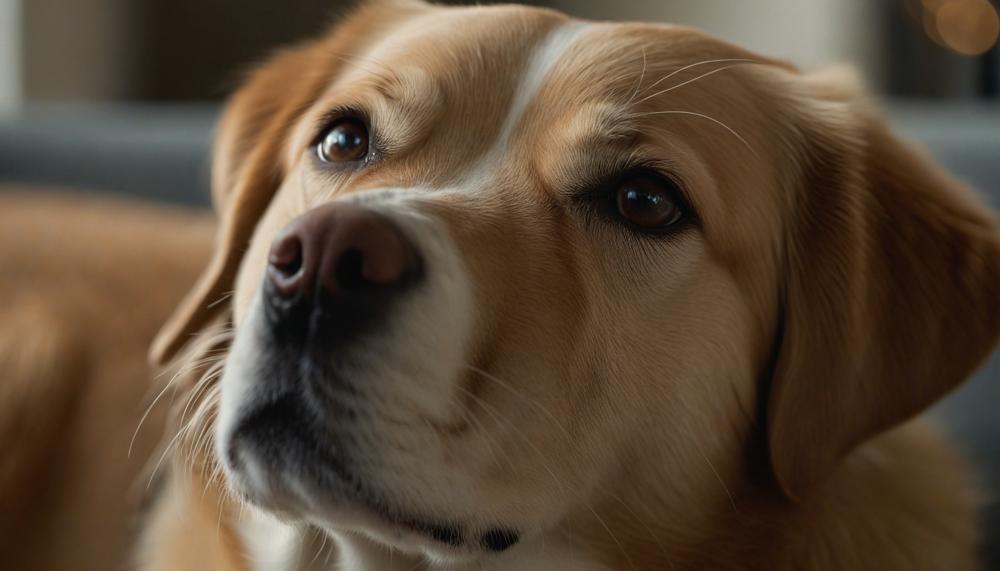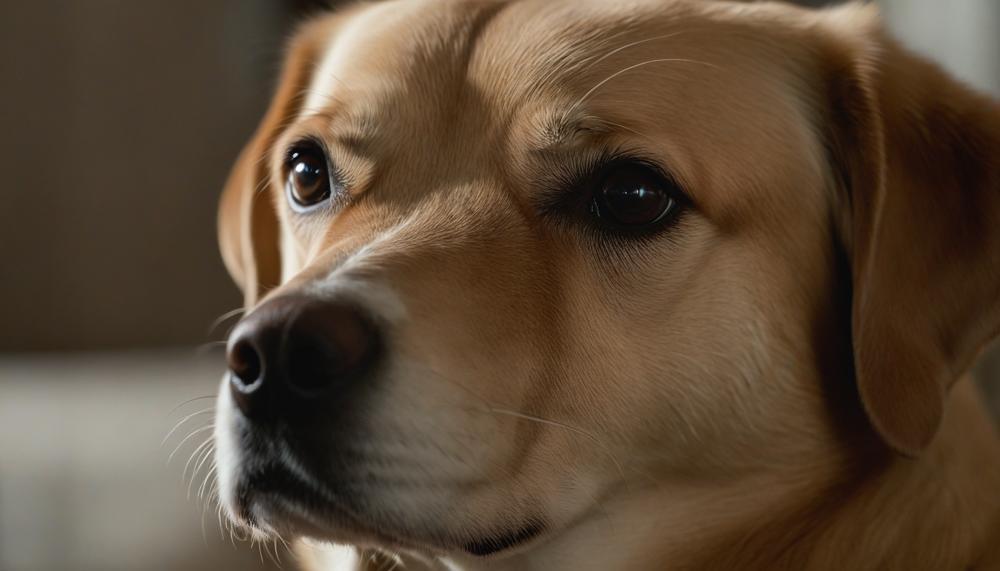Imagine leaning in to kiss your beloved dog, expecting a wagging tail and playful nuzzles, only to be met with a growl. Surprisingly, about 30% of pet owners report experiencing some form of defensive behavior from their pets when displaying affection. This reaction underscores a fascinating aspect of pet ownership: the necessity of understanding canine responses to human actions.
Why does your dog growl when you shower him with kisses? While often perplexing and sometimes distressing, this behavior is a complex communication tool for dogs. Here are some insights into why your furry companion might not be as enthusiastic about your kisses as you are:
- Personal Space: Dogs, like people, have personal space needs. A kiss, while a sign of affection for humans, invades their space and can be overwhelming.
- Communication Differences: Dogs communicate differently than humans. A growl might not always signify aggression; it could be discomfort or even an odd way of showing affection.
- Past Experiences: Previous negative experiences associated with face-to-face interactions can lead dogs to react defensively.
- Individual Preferences: Just as humans have different comfort levels with physical touch, so do dogs. Some simply don’t enjoy being kissed.
Understanding these triggers and respecting your dog’s boundaries can significantly improve the bond you share. This introductory exploration into why dogs might growl when kissed is just the tip of the iceberg.
As we dig deeper, we will uncover more about the nuances of canine behavior, ensuring that your affection truly resonates with your four-legged friend.
Why Do Dogs Growl?
Table of Contents
Dogs growl for a multitude of reasons, each serving as a crucial aspect of their communication arsenal. Here’s a detailed look into the motives behind growling and strategies to address it:
- Communication: Dogs often use growling to convey a variety of emotional states—from anxiety and fear to aggression and playfulness. Understanding the context of the growl helps in interpreting what your dog is trying to communicate.
- Warning Signal: Growling serves as a prelude to potential aggression. It is a way for dogs to indicate that they feel threatened or are uncomfortable with a situation or near presence.
- Expression of Pain: If your dog is injured or ill, growling may be their method of indicating that they are in pain and need care or space.
- Playful Interaction: Not all growls are signs of distress; sometimes, they are part of playful behavior, especially seen when dogs engage with other dogs or their owners.
Addressing growling involves understanding its root causes and responding appropriately:
| Cause | Understanding | Response |
| Communication | Observe body language to determine the emotion being expressed. | Respond accordingly, provide comfort or space as needed. |
| Warning Signal | Recognize signs of discomfort or threat. | Remove or avoid the stressor, allow the dog to retreat. |
| Pain | Notice if the growl occurs during specific movements or interactions. | Consult a vet to address any health issues. |
| Playful | Check if the growl occurs in a relaxed, playful setting. | Ensure play remains safe and positive, intervene if intensity escalates. |
Key Strategies:
- Observe and React: Pay close attention to the circumstances around when your dog growls. This observation can help determine whether they feel playful, threatened, or are in pain.
- Avoid Punishment: Suppressing growling by punishment can lead to worse behaviors like biting. It’s crucial to respect this natural communication and not discourage it through negative reinforcement.
- Seek Professional Help: Persistent growling in non-playful contexts might require intervention from a professional, such as a veterinarian or a certified animal behaviorist, to address underlying issues like anxiety or aggression.
Understanding and addressing dog growling with empathy and care not only helps in preventing aggressive outbursts but also supports the development of a trusting relationship between you and your dog.
Pain
To discern whether your dog’s growling during a kiss is rooted in pain, keen observation and understanding of context are paramount.
Dogs express discomfort in varied ways, and growling can be a significant indicator. Below are structured insights and a table to help you recognize signs of pain versus other causes of growling:
Key Observations to Consider
- Body Language: A dog in pain might exhibit stiffness or flinch away when touched. Look for signs such as a tucked tail, lowered head, or reluctance to move, which are not typical of a dog growling out of pleasure or discomfort from affection.
- Consistency and Context: If the growling occurs specifically when touched in a particular area, it might indicate pain. Contrast this with growling that happens randomly or in various scenarios, which could suggest behavioral reasons.
- Changes in Behavior: Note any recent changes in your dog’s behavior, such as decreased activity, loss of appetite, or unusual aggression, which can accompany pain.
- Previous Experiences: If your dog has a history of trauma or discomfort being touched, the growling could be more about fear or discomfort rather than pain.
Helpful Table for Quick Reference
| Sign | Pain-Induced Growling | Other Causes of Growling |
| Body Language | Stiff, flinching, avoidance | Relaxed, possibly playful or alert |
| Context of Growling | When touched in specific areas | During play, or when feeling threatened |
| Behavioral Changes | Withdrawn, less active, eating less | No significant change or linked to specific scenarios |
| History | Medical issues or recent injuries | Past abuse, lack of socialization, or no clear pattern |
Fear
A dog may growl when being kissed for various reasons, often stemming from discomfort or fear. Below is a table detailing possible causes and how fear influences this behavior:
| Reason | Description | Role of Fear |
| Personal Space | Dogs value their personal space, and kissing invades this space, causing discomfort. | Fear may stem from feeling trapped or overwhelmed by close proximity, especially in timid or previously abused dogs. |
| Past Trauma | Rescue or shelter dogs with a history of abuse might associate close contact with past negative experiences. | Fear from past abuse can make a dog hypersensitive to touch and quick to respond with a growl as a defensive mechanism. |
| Miscommunication | Dogs do not naturally understand kisses; this human expression might be confusing or alarming to them. | A dog might react with fear if they misinterpret the kiss as a threat, leading to defensive growling. |
| Dislike of Person | A dog might growl when kissed by someone they have negative associations with or do not trust. | Fear can be exacerbated if the dog feels threatened by the specific person’s presence, prompting a growl to maintain distance. |
Understanding your dog’s behavior and the signs they show is key to recognizing when they are comfortable with physical affection and when it might be causing them stress or fear.
Observing their body language, like tail wagging, relaxed posture, or the opposite—tensing up, avoiding eye contact, or pulling away—can provide clues about their feelings toward receiving kisses.
If you notice signs of discomfort, it’s advisable to refrain from kissing and instead show affection in ways your dog finds more agreeable.
Territoriality
Territoriality plays a crucial role in a dog’s response to physical affection, including kissing, by shaping their reactions based on their instinct to guard their space and possessions. This behavioral trait varies significantly among dogs depending on their breed, individual temperament, and past experiences.
Here’s a breakdown of how territoriality influences their behavior towards physical affection:
Reaction to Space Invasion: Dogs that exhibit strong territorial instincts may perceive kisses or close physical contact as a threat to their personal space. This can trigger defensive behavior as they feel the need to protect their territory from what they interpret as an intrusion.
Breed-Specific Tendencies: Some breeds are more prone to territorial behavior due to their genetic predisposition. For example, guard dogs like Dobermans or Rottweilers may display more protective responses towards physical affection, especially in areas they consider their domain.
Individual Differences: The level of territoriality can also vary widely between individual dogs within the same breed. Factors such as past experiences, training, and socialization play significant roles in shaping their territorial responses.
Misinterpretation of Human Actions: Dogs may not inherently understand the affectionate intent behind human actions like kissing. If a dog interprets such actions as a challenge or threat within their territory, it could lead to uncomfortable or aggressive reactions.
Table: Influence of Territoriality on Dog’s Reaction to Kissing
| Breed | Typical Territorial Level | Likely Reaction to Kissing |
| Guard Dogs (e.g., Rottweiler) | High | Defensive, potentially aggressive |
| Companion Dogs (e.g., Labrador) | Low to Moderate | Generally accepting, less defensive |
| Independent Breeds (e.g., Akita) | High | Reserved, possibly hostile |
Understanding and respecting a dog’s territorial boundaries is essential for fostering a positive and safe interaction. Owners should observe their dog’s body language and reaction to determine their comfort levels with physical affection and adjust their approach accordingly.
Possession Aggression
To safely address your dog’s possession aggression, specifically when you attempt to kiss them, it’s vital to adopt a methodical approach grounded in understanding their behavioral cues and reinforcing positive interactions. Here’s a strategy using desensitization and counterconditioning, which gradually accustoms your dog to the trigger (kissing) while associating it with positive experiences:
- Identify and Understand Triggers: Observe and note the circumstances under which your dog exhibits aggressive behaviors. Is it only when being kissed or are there other scenarios?
- Gradual Desensitization: Start by getting close to your dog without kissing. Over days or weeks, progressively decrease the distance at which you interact with them, always observing their comfort level.
- Counterconditioning: Pair the presence of the trigger (getting closer to kiss) with something your dog loves, like their favorite treat or toy. This creates a positive association with the action.
- Set Boundaries and Training: Establish clear boundaries. Use commands like “sit” or “stay” to foster calm behavior before attempting to kiss. Reward compliance with treats and affection.
- Professional Guidance: Consider consulting with a professional dog trainer or behaviorist, especially if progress stalls or if aggressive behaviors escalate.
It’s crucial to proceed with patience and to avoid punishment, which can exacerbate aggression. Each dog’s pace will differ, and some may require more time to adjust to changes in their environment and interactions.
Here’s a table outlining steps and tips to integrate into your approach:
| Step | Action | Tips |
| Observe | Monitor your dog’s reactions | Keep a diary of triggers |
| Desensitize | Gradually decrease distance | Proceed at your dog’s comfort pace |
| Countercondition | Introduce positive stimuli | Use high-value treats |
| Train | Implement command training | Be consistent and patient |
| Consult | Seek professional advice | Choose a certified behaviorist |
Having Fun
Answer: Deciphering your dog’s growl during affectionate moments such as kissing can be puzzling, yet it’s vital to read the cues correctly to ensure safety and positive interactions. Dogs communicate a lot through their growls, but the tone, body language, and situation are key to understanding their intent.
To differentiate between a playful and aggressive growl, observe the following aspects:
- Tone of the Growl: A playful growl often sounds lighter and may be mixed with barks or yips. An aggressive growl tends to be deeper and more guttural.
- Body Language: During playful interactions, your dog’s body is relaxed with possibly a wagging tail and an overall loose posture. In contrast, aggressive signals include stiffening of the body, raised hackles, bared teeth, and a fixed stare.
- Context: If the growling occurs in a generally calm and happy scenario without any signs of tension over resources or discomfort, it’s likely playful. However, if your dog growls when there are stressors around or if it’s during a moment where he might feel threatened (like someone leaning over him), the growling could be aggressive.
For your clarity, here’s a comparative table:
| Aspect | Playful Growling | Aggressive Growling |
| Tone | Lighter, mixed with playful sounds | Deep, guttural |
| Body Language | Relaxed, wagging tail | Stiff, raised hackles, bared teeth |
| Context | During play, with toys or other dogs | When stressed or threatened |
If you remain uncertain about your dog’s behavior, consulting a professional trainer or behaviorist can provide further insights. They can observe your dog in various contexts and offer tailored advice based on their observations.
How to Stop Growling
Addressing a dog’s growAddressing a dog’s growling when being kissed involves understanding and respecting their comfort and communication. Here’s a detailed guide:
| Step | Technique | Description |
| 1 | Recognize the Growl | Identify what the growl signifies – pain, fear, or discomfort. Never scold your dog for growling, as it is their way of communication. |
| 2 | Assess the Situation | Determine the specific triggers for growling. Is it only when being kissed, or are there other situations that provoke this reaction? |
| 3 | Modify Your Approach | Instead of kissing, show affection in ways your dog enjoys and feels comfortable with, like gentle petting or verbal praise. |
| 4 | Training | Consult with a professional trainer or behaviorist to address any underlying issues like fear or aggression through positive reinforcement techniques. |
| 5 | Medical Check-Up | Ensure there’s no medical condition causing discomfort or pain that could be contributing to the growling. Regular vet visits are crucial. |
Each step is essential for understanding and effectively managing your dog’s behavior.
By paying close attention to their needs and signals, you can foster a more trusting and comfortable relationship with your furry companion.
In-Depth Training
In-depth training offers a structured approach to understanding and rectifying your dog’s growling when kissed, capitalizing on professional insights into canine behavior and tailored interventions. Here’s a breakdown of how this training is pivotal:
- Identification of Triggers: Professional trainers can discern subtle cues that precede growling, pinpointing specific triggers such as proximity or the act of kissing itself. This precise identification is crucial for effective modification.
- Communication Enhancement: Training enriches your understanding of dog body language, enabling preemptive action before discomfort escalates to growling. Recognizing signs of anxiety or stress in your dog allows for a timely and appropriate response.
- Behavioral Adjustment: Trainers implement techniques like desensitization and counterconditioning to replace negative associations (like fear of kissing) with positive outcomes (treats and praise), altering your dog’s response to being kissed.
- Establishing Boundaries and Commands: Clear instructions and boundaries are established during training, teaching dogs acceptable ways to express discomfort. Commands like ‘sit’ or ‘stay’ can redirect their focus and reduce the incidence of growling.
Here’s how these elements integrate into a training plan:

| Training Component | Techniques Used | Outcome |
| Trigger Identification | Observation and feedback | Understand specific causes of growling |
| Enhanced Communication | Body language education | Prevent escalation by responding to early signs |
| Behavioral Adjustment | Desensitization, counterconditioning | Replace negative reactions with positive ones |
| Command Training | Command reinforcement | Teach alternative behaviors to growling |
Through in-depth training, you gain the skills to not only address the growling but also to foster a deeper bond with your dog, built on mutual respect and understanding.
Conclusion
Understanding your dog’s growling when you try to kiss him is key to nurturing a stronger, more respectful bond. Dogs have their unique ways of communicating, and growling is one such method, not always indicative of aggression. It could be a sign of discomfort, a plea for personal space, or an unusual expression of affection.
Just as humans have varied preferences for personal interaction, our canine companions have their boundaries that need to be recognized and honored.
Growling can be influenced by several factors, including past experiences and individual temperament. For instance, a rescue dog may have had negative experiences with close contact, making them more likely to react defensively.
On the other hand, a dog might simply prefer to show affection differently—through play or companionship rather than close physical contact.
To foster a loving relationship where both you and your dog feel comfortable, it’s crucial to pay attention to his signals. Tailor your expressions of affection to suit his comfort level. Instead of a kiss, a gentle pat or verbal praise might be more appreciated and can go a long way in strengthening the trust between you and your furry friend.






